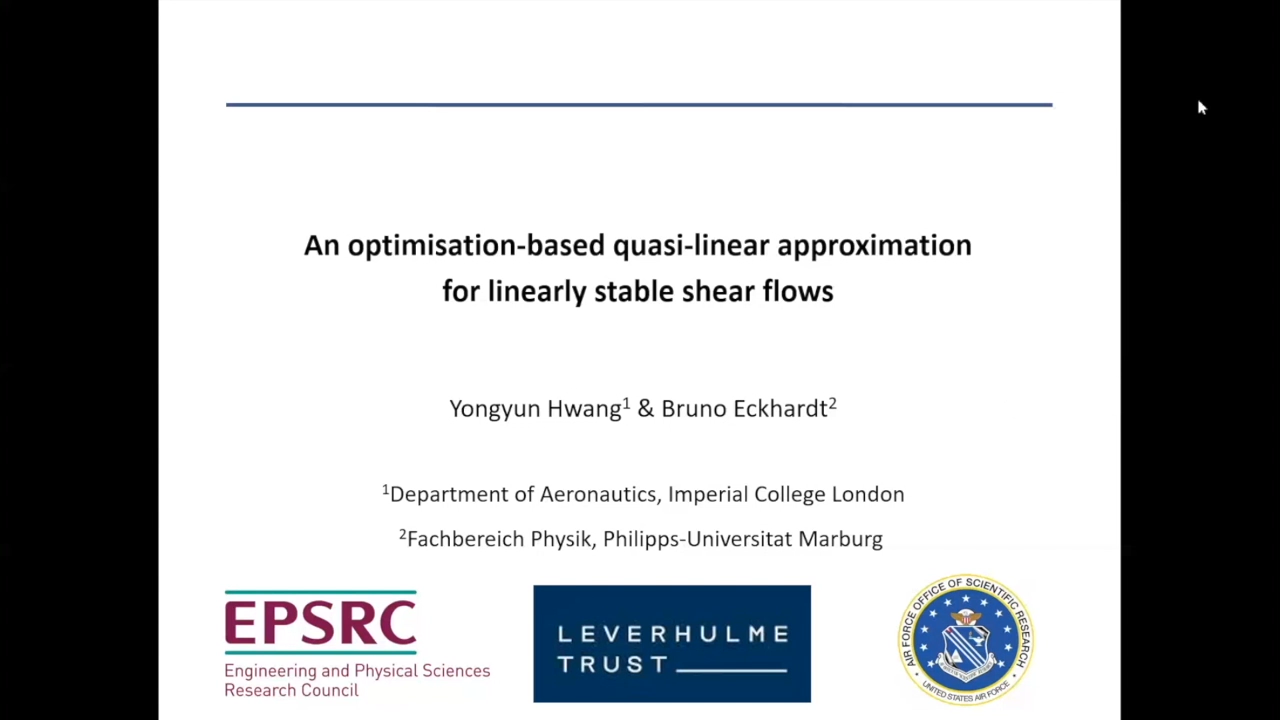An optimisation-based quasi-linear approximation for linearly stable shear flows: application to turbulent channel flow up to Re_tau=20,000
Duration: 19 mins 10 secs
Share this media item:
Embed this media item:
Embed this media item:
About this item

| Description: | Presentation by Yongyun Hwang (Imperial College London) at online meeting on 'Data Assimilation in Fluid Mechanics', organised by the UK Fluids Network Special Interest Group 'Flow instability, modelling and control', 27th May 2020. |
|---|
| Created: | 2020-06-16 10:26 |
|---|---|
| Collection: | Data Assimilation in Fluid Mechanics - 1st online meeting of UKFN SIG 'Flow instability, modelling and control' |
| Publisher: | University of Cambridge |
| Copyright: | Yongyun Hwang |
| Language: | eng (English) |
| Abstract: | A quasi-linear approximation for linearly stable mean flow is proposed and applied to turbulent channel flow. The velocity field is decomposed into a mean profile and fluctuations. While the mean is obtained from the nonlinear equations, the fluctuations are modelled by replacing the nonlinear self-interaction terms with an eddy-viscosity-based turbulent diffusion and stochastic forcing. The stochastic forcing is then determined self-consistently by solving an optimisation problem which minimises the difference between the Reynolds shear stresses from the mean and fluctuation equations, subject to a constraint that the averaged Reynolds shear-stress spectrum is sufficiently smooth in the spatial wavenumber space. The proposed quasi-linear approximation is subsequently applied to channel flow for Reynolds number Re_tau ranging from 500 to 20,000. The best result is obtained when the Reynolds stress is calculated by retaining only the two leading POD (proper orthogonal decomposition) modes, which further filters out the modelling artifact caused by the unphysical stochastic forcing. In this case, the resulting turbulence intensity profile and energy spectra exhibit the same qualitative behaviour as DNS data throughout the entire wall-normal domain, while reproducing the classical predictions made by Townsend (1956). |
|---|---|
Available Formats
| Format | Quality | Bitrate | Size | |||
|---|---|---|---|---|---|---|
| MPEG-4 Video | 1280x720 | 1.04 Mbits/sec | 149.73 MB | View | Download | |
| MPEG-4 Video | 640x360 | 262.8 kbits/sec | 36.89 MB | View | Download | |
| WebM | 1280x720 | 439.85 kbits/sec | 61.80 MB | View | Download | |
| WebM | 640x360 | 194.36 kbits/sec | 27.31 MB | View | Download | |
| iPod Video | 480x360 | 476.25 kbits/sec | 66.86 MB | View | Download | |
| MP3 | 44100 Hz | 249.81 kbits/sec | 35.34 MB | Listen | Download | |
| Auto * | (Allows browser to choose a format it supports) | |||||

